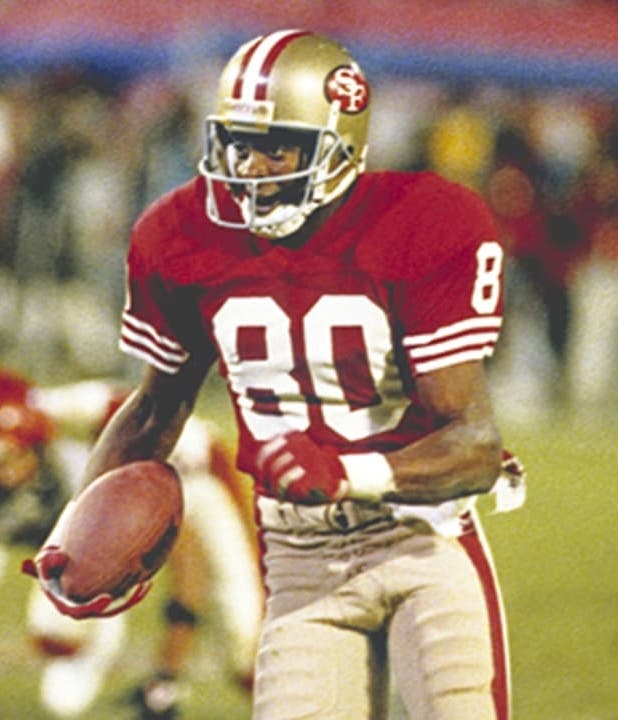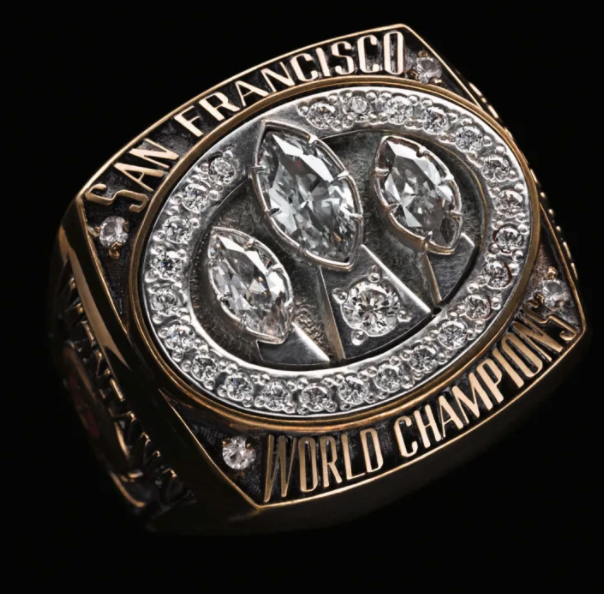By the time the NFL penned Super Bowl XXIII into the schedule, the San Francisco 49ers were asserting themselves as a dynasty. The 49ers — led by two-time Super Bowl MVP Joe Montana — were looking to go three for three on their Super Bowl appearances, the first of which was seven years earlier. Meanwhile, the Cincinnati Bengals returned to the big stage for the third-ever Super Bowl rematch — a rewind of Super Bowl XVI where the 49ers won 26-21.
January 22, 1989, marked yet another close Super Bowl and a return to Miami for the first time in a decade, albeit not in the usual Orange Bowl. By the time you're done reading this article, you'll know which 80s star belted the National Anthem before the game, what nearly triggered a last-minute location change, and what broadcasting feat the winning team accomplished.
The 1988-89 Bengals season was miraculous following a dreadful 4-11 record the season before, finishing with a more impressive 12-4 record this time around. Calling the plays was first-time Super Bowl quarterback Boomer Esiason, who earned the league MVP title, threw for 3,572 yards, and threw twice as many touchdowns as interceptions (28 vs. 14).
Cincinnati's offensive line also didn't go unnoticed, with a star-studded roster including wide receiver Eddie Brown (a franchise-best 1,273 yards and 24 yards per catch) and fullback Ickey Woods (1,066 rushing yards and 15 touchdowns). The Bengals undoubtedly had the best offense in the league — 448 points, 2,710 rushing yards, and 6,302 total yards.
However, despite having studs like Jim Skow (9.5 sacks) and Reggie Williams returning for his second Super Bowl with the team on defense, Cincanniti's defensive line was little more than mediocre (17 out of 28).
The San Francisco 49ers were coming off a three-year drought in playoff victories by the time Super Bowl XXIII rolled around — and the 1988-89 season was almost a repeat of this trend. The team nabbed a dismal 10-6 regular-season record and would've missed playoff contention had they lost just one more game. Still leading the squad in San Francisco was veteran quarterback Joe Montana, boasting 2,981 yards, 18 touchdowns, and 132 rushing yards on the season.
The biggest scoring threats on the roster were receiver Jerry Rice (averaging 20.4 yards per catch), running back Roger Craig (76 receptions and ten touchdowns), and receiver John Taylor (556 punt return yards). San Francisco succeeded defensively thanks to a defensive back trio snagging 18 interceptions, linebacker Charles Haley's 11.5 sacks, and four other players with five or more sacks.
Super Bowl XXIII almost didn't happen in Miami after rioting in Overtown (Miami) following a police-involved shooting just six days earlier. However, the NFL opted against relocating the game to Tampa and instead used these events to look into their own hiring practices, specifically the lack of African-American coaches in the league.
On January 22, 1989, around 75,129 football fans rushed into Joe Robbie Stadium down in Miami, Florida — marking a monumental return to "The Magic City" since Super Bowl XIII ten years earlier. It cost fans about $100 for a ticket (valued at $209.90 today) in hopes of seeing the 49ers clinch their third Super Bowl while also catching a rematch of Super Bowl XVI (1982).
Gameday began with an honorary tribute to NASA — a program piloted out of nearby Cape Canaveral — and a powerful National Anthem performance by "Piano Man" crooner Billy Joel. Following a coin toss ceremony led by several former Dolphins standouts (including Bob Griese) that landed on tails, Super Bowl XXIII got off to the last early start in history (around 5 PM).
Super Bowl XXIII began slowly. Montana and the 49ers managed to advance 73 yards down the field but couldn't make good on a scoring attempt by receiver Mike Wilson. Instead, 49ers kicker Mike Cofer clinched a 41-yard field goal to give San Francisco an early 3-0 lead.
The 49ers continued on a scoring pursuit early in the second quarter. Cincinnati safety David Fulcher tackled fullback Tom Rathman just yards away from the end zone to keep San Francisco off the board and force Cofer to try for another field goal. An awful snap obliterated Cofer's timing on the kick, allowing him to miss the shortest field goal in Super Bowl history — 19 yards.
The next punt set two Super Bowl records that stood for nearly three decades: The longest punt (63 yards, Lee Johnson, Bengals) and the longest punt return (45 yards, John Taylor, 49ers). Both teams traded punts and bungled scoring opportunities until Cincinnati kicker Jim Breech nabbed a 34-yard field goal. The score was 3-3 at the half.
Super Bowl XXIII was an exciting and close match-up by the time halftime arrived, but the night took on a far stranger vibe when a magician moonlighting as an Elvis impersonator took the field. This "Be Bop Bamboozled in 3-D" halftime show included a stadium-wide card trick, performances by talented local dancers, a fireworks display, a 50s-themed Harley Davidson, a curious selection of Broadway songs, and (surprisingly) not a single Elvis tune.
Coca Cola and NBC also joined forces for a first-of-its-kind Super Bowl halftime performance: A 3-D commercial sponsored by Diet Coke. Though all fans in the stadium felt mesmerized by the concept of 3-D anything, not all viewers in the 50+ million households tuning in had the same experience — local distributors quickly ran out of 3-D glasses to achieve the full experience.
Both teams took the second quarter more seriously. The Bengals held possession for over nine minutes as they crushed through 61 yards. After clean 20+ yard passes from Esiason to Brooks and Collinsworth, Breech successfully found the uprights on a 43-yard field goal. However, the 49ers responded immediately with a field goal of their own stemming from an interception by Bill Romanowski — a game-tying 32-yard field goal by Cofer.
Looking to avoid being a part of the first Super Bowl without a touchdown in the first three quarters, Bengals running back Stanford Jennings took off on a 93-yard mad dash on the kickoff. Jennings fell into the endzone to give the Bengals a widened 13-6 lead and himself a position in the record books as only the second Super Bowl player to score on a kickoff.
Just a minute into the fourth quarter, an 85-yard 49ers drive ending on a 14-yard pass from Montana to Rice quickly tied the game to 13-13. With just three minutes left in the game, the Bengals — with the help of Hillary, Woods, and Brooks — pressed down the field for another Breech field goal (40 yards).
The Bengals, now up 16-13, expected Joe Montana to organize plays along the sidelines to keep time on the clock. Montana did the opposite, and the 49ers recovered from overthrown passes and penalty setbacks before Montana connected a 10-yard touchdown pass to Taylor with 34 seconds left. San Francisco won narrowly with a 20-16 victory over the Bengals.
San Francisco wide receiver Jerry Rice brought his impressive talent and his knack for long catches to Joe Robbie Stadium. Rice was responsible for a game-tying touchdown in the final quarter of Super Bowl XXIII, which helped him earn MVP honors:

Jerry Rice went on to play another 16 years in the NFL — 11 of which he spent with the San Francisco 49ers — and successfully nabbed a spot in the coveted Pro Football Hall of Fame.
The 20th anniversary of the Super Bowl lured in over 127 million at-home viewers, but viewership was on a steady decline since. The NBC broadcast of Super Bowl XXIII yielded just 110.8 million viewers — down 3.8 million from the previous championship — but managed a slightly higher 43.5 Nielsen rating.
Like so many Super Bowls before it, Super Bowl XXIII was a star-studded affair in the studio and announcer's booths — Don Shula, Bob Costas, and Al Roker took part in the coverage, to name a few. The 49ers' third Super Bowl win also came with a first-of-its-kind feat: The first team in league history to win a Super Bowl on all three major television networks (ABC, CBS, and NBC).
The Bengals and the 49ers were two teams with entirely different playing styles and talents joining together for one low-profile Super Bowl. San Francisco hardly secured a 10-6 regular-season record and narrowly qualified for playoff contention, but still had Super Bowl MVP Joe Montana leading the pack. Meanwhile, Cincinnati scored the most in the NFL (448 points) but ranked #17 on the defensive front.
With that, the 49ers approached Super Bowl XXIII as favorites by 7 points. But despite beating the Bengals 20-16 and nabbing their third-ever Super Bowl, the 49ers didn't win by enough to cover the spread — the Bengals covered the spread by a slim three-point margin. And with a 48-point over/under, the 36 points scored in Super Bowl XXIII yielded an "under" ruling by 12.

San Francisco's return to the big stage catapulted Joe Montana back into the national spotlight, though he didn't win the MVP title. It also gave the team its third Super Bowl victory and enough momentum to qualify for the championship the following season. But would San Francisco become the second-ever team to win two back-to-back Super Bowls?